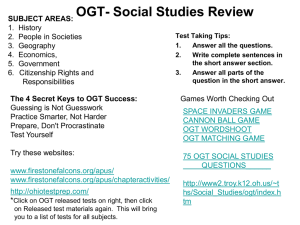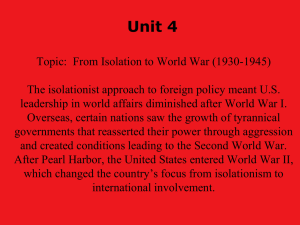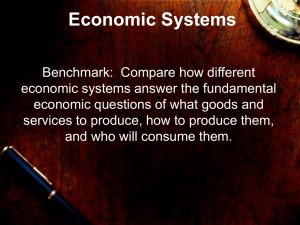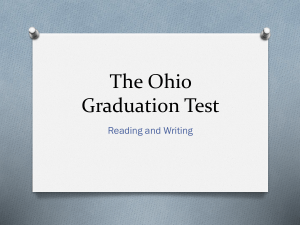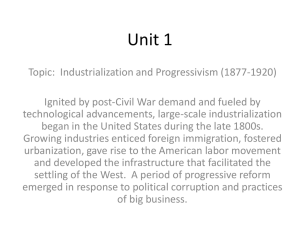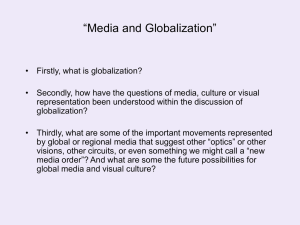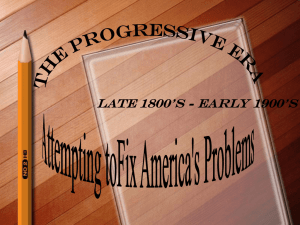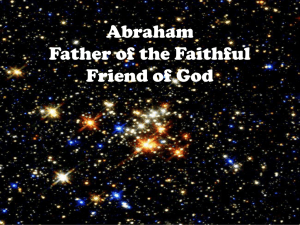Unit 6 Chapter 1 Power Point Gender and Race Equality
advertisement
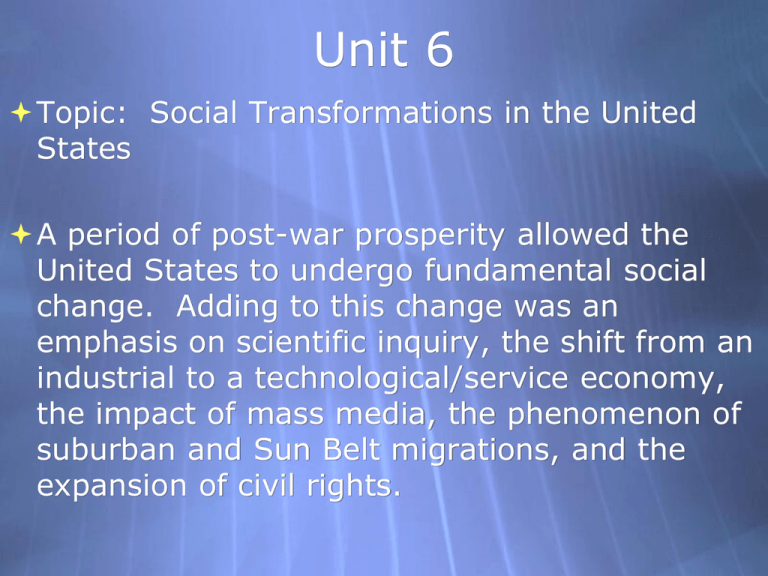
Unit 6 Topic: Social Transformations in the United States A period of post-war prosperity allowed the United States to undergo fundamental social change. Adding to this change was an emphasis on scientific inquiry, the shift from an industrial to a technological/service economy, the impact of mass media, the phenomenon of suburban and Sun Belt migrations, and the expansion of civil rights. Chapter 1: Social Movements for Equality Content Statement: Following World War II, the United States experienced a struggle for racial and gender equality and the extension of civil rights. Expectations for Learning: Summarize the struggle for racial and gender equality and the extension of civil rights that occurred in the United States in the postwar period. Section 1: African Americans Content Elaboration: African Americans, Mexican Americans, American Indians and women distinguished themselves in the effort to win World War II. Following the war, movements began to secure the same freedoms and opportunities for these Americans that other Americans enjoyed. Content Elaboration: African-American organizations such as the National Association for the Advancement of Colored People (NAACP), the Southern Christian Leadership Conference (SCLC), the Student Nonviolent Coordinating Committee (SNCC) and the National Urban League (NUL) struggled for equal opportunities and to end segregation. They demonstrated and sought redress in the courts to change long-standing policies and laws. Jim Crow Laws Reveiw A. After the Civil War (1870’s) B. Laws passed to segregate whites and blacks C. mostly in Southern states D. whites controlled state legislatures E. Brown vs. Board of Education Plessy vs. Ferguson 1898: “Separate but equal” is constitutional Brown vs. Board of Education of Topeka, Kansas 1954: Separate but equal is unconstitutional The South Resists--Little Rock, Arkansas A. B. South would not integrate schools Little Rock, Arkansas (1957) 1. school board tries to integrate--9 blacks were to enroll in school 2. National Guard called in to prevent blacks from entering the school 3. Federal judge gets Nat. Guard out 4. Sept. 23, 1957. Blacks enter school. 5. White mob forced them out 6. President Eisenhower sends in federal troops to protect the African-American students and allow them into the school 7. IMPORTANT: 1st time Federal Gov. intervenes to advance the rights of African-Americans 8. This event televised: people’s opinion changed: against racism and for civil rights QuickTime™ and a TIFF (Uncompressed) decompressor are needed to see this picture. QuickTime™ and a TIFF (Uncompressed) decompressor are needed to see this picture. Montgomery Bus Boycott • A. Martin Luther King and Mrs. Rosa Parks • 1. King • a. Born in Atlanta, 1929 • b. son of a minister • c. attended Morehouse College • d. Doctor’s degree in theology--Boston Univ. • e. Natural leader--use peaceful tactics • 2. Parks • a. Dec. 1, 1955 • b. Sat in front of bus in Montgomery, Ala. • c. She was told to get up • d. Police arrested her • C The nonviolent way • 1. King--agreed Parks case was wrong • a. use nonviolence to show opposition • 2. Bus boycott • a. 381 days • -- car pool • -- walk to work • -- some lost jobs--couldn’t get there • b. bus companies almost bankrupt • -- blacks won this case • ***A start to desegration everywhere!!!! QuickTime™ and a TIFF (Uncompressed) decompressor are needed to see this picture. QuickTime™ and a TIFF (Uncompressed) decompressor are needed to see this picture. Rosa Parks Martin Luther King, Jr. Quick Time™ and a TIFF ( Uncompr ess ed) decompr ess or ar e needed to s ee this pic ture. QuickTime™ and a TIFF(Uncompressed) decompressor are needed to see this pi cture. Sit-Ins and Freedom Riders » A. Sit-Ins » 1. 1960’s: civil rights movement picked up momentum » 2. Greensboro, NC: students stage sit-in at a segregated lunch counter (1960) » 3. other non-violent protests followed » B. Freedom Riders » 1. » 2. » 3. » 4. From the north They went south to try to end segregation Both blacks and whites participated Group led by James Farmer Group called Congress of Racial Equality (CORE) » 5. a. Goal: take trips to South to make sure segregation »laws were being enforced Quic kTime™ and a TIFF ( Unc ompres s ed) dec ompres s or are needed to s ee this pic tur e. James Farmer Quic kT ime™ and a T IFF (Uncompress ed) dec ompress or are needed to s ee this pic ture. Violent Backlash • A. Medgar Evers • • • • • • • • • • 1. NAACP leader 2. murdered in Jackson, Mississippi (1963) B. University of Mississippi 1. Black student named James Meredith wants to enroll 2. Riots broke out 3. Courts ordered U. of Mississippi to let him in 4. Meredith’s life was threatened 5. JFK sent federal marshals to help out 6. Meredith became first black at Ole Miss Medgar Evers and the driveway in which he was killed QuickTime™ and a TIFF (Uncompressed) decompressor are needed to see this picture. QuickTime™ and a TIFF (Uncompressed) decompressor are needed to see this picture. • • • • • • • • • • C. Birmingham, Alabama (1963) 1. racists bombed Baptist church, killing 4 young African-American girls D. 1960’s: Violence on both sides of civil rights increased E. The march on Washington 1. August 28, 1963 a. 250,000 people at Lincoln Memorial b. Organized by black leaders c. For support of civil rights d. Men, women, black, and whites e. waved flags, sang songs, speeches 2. MLK spoke a. “I have a dream” speech given b. said nation should show that “all men are created equal” F. 1968: Martin Luther King, Jr. assassinated March on Washington Q uic kT ime™ and a T IFF (Unc ompress ed) decompres sor ar e needed to see t his pic tur e. QuickT ime™ and a T IFF (Uncompressed) decompressor are needed to see t his picture. Quick Time™ a nd a TIFF ( Un compr ess ed ) de co mp res sor ar e n eed ed to s ee this pic tur e. King Assassination QuickTime™ and a TIFF (Uncompressed) decompressor are needed to see this picture. Qui ckTime™ and a TIFF (Uncompressed) decompressor are needed to see this picture. Summary: Events of the Civil Rights Movement, 1964-1971 • 1964 CORE and SNCC launched massive voter registration drive aimed at AfricanAmericans; known as the Freedom Summer • 1964 Civil Rights Act made segregation in public facilities and discrimination in employment illegal. • 1964 Three civil rights workers in Mississippi killed by racists • 1965 Black nationalist leader Malcolm X assassinated in Harlem by Black Muslins • 1965 African Americans ld by Martin Luther King, Jr. marched to Montgomery in support of voting rights; stopped by police blockade; several marchers injured after police use tear gas, whips, and clubs; known as “bloody Sunday.” • 1965 Congress passed Voting Rights Act, which made it easier for Southern blacks to register; literacy tests became illegal • 1965-1968 Race riots in Los Angeles, Newark, New York, Cleveland, Detroit, and Chicago • 1968 Martin Luther King, Jr., assassinated in Memphis, Tennessee • 1968 Civil Rights Act prohibited discrimination in the sale, rental, and financing of housing. • 1971 Supreme Court decision Swann v. CharlotteMecklenburg Board of Education ruled that busing is a legitimate means for achieving integration of public schools. OGT Multiple Choice • Which of the following tactics did Martin Luther King, Jr. urge his followers to practice? • A. collective bargaining • B. nonviolent demonstration • C. massive retaliation • D. nonpeaceful coexistence OGT Multiple Choice • (OGT Test, 2008) What is one direct consequence of the U.S. civil rights movement of the 1950s and 1960s? • A. the right to freedom of religion for all citizens • B. the end of legal segregation in public places • C. the granting of citizenship to AfricanAmericans • D. the passing of legislation to protect the accused OGT Multiple Choice • (OGT Test, 2008) In 1977, advocates for people with disabilities staged a series of protest demonstrations across the country. These demonstrations urged enforcement of anti-discrimination legislation. The demonstrations continued a pattern of protests for equal treatment under the law influenced by • A. anti-war protests during the Vietnam War. • B. civil rights marches of the 1950s and 1960s. • C. farm labor strikes of the 1960s. • D. Ku Klux Klan rallies of the 1920s. OGT Multiple Choice • Martin Luther King, Jr. was a leader in which one of the following events? • A. the Little Rock school crisis • B. Brown vs. Board of Education • C. the Montgomery bus boycott • D. the lunch counter sit-in OGT Multiple Choice • (Practice Test Booklet 2005) The Supreme Court decision in Plessy v. Ferguson in 1896 established the principal of • A. one man, one vote • B. separate but equal • C. runaway slaves were property • D. desegregation in schools OGT Multiple Choice • (Practice Test Booklet 2005) Rosa parks played an important role in the civil rights movement for African-Americans. In 1955 in Montgomery, Alabama, she • A. was the first African-American to be elected mayor • B. led a successful civil rights demonstration at the steps of the state capital • C. successfully integrated a restaurant, which had been for whites only • D. refused to give up her seat on a bus to a white man OGT Multiple Choice • (Practice Test Booklet 2005) In 1955 in Montgomery, Alabama, Rosa Parks broke the law by refusing to give up her seat on a bus to a white man. One result of her civil disobedience was • A. African-Americans were no longer allowed to ride the same buses as whites • B. a year-long boycott of riding the buses by African-Americans • C. African-Americans continued to ride in the back of the buses • D. it had little impact because she was not well-known OGT Extended Response • Throughout the Civil Rights movement, African-Americans used several types of nonviolent protests. (4 points) • List and explain 2 types of nonviolent protests used. • Do you feel nonviolent protests or violent protests are better? Why? Political Action Groups • A. Historically: Americans form groups of like-minded people to achieve goals • B. Perspective: dictates how a group views a problem • C. Groups sometimes form Political Action Groups or Political Action Committees (PAC’s) – 1. try to get government to help – 2. organize public awareness – 3. Examples: • • • • NAACP (African-Americans) NOW (National Organization of Women AIM (American Indian Movement) UFW (United Farm Workers—Hispanic Americans) I. National Association for the Advancement of Colored People (NAACP) • A. Began in 1903 • 1. 60 met in New York City • 2. Whites and blacks, including Ida B. Wells-Barnett and W.E.B. DuBois • 3. horrified over racial violence • 4 use legal system to achieve goals • a. equal protection for all • b. universal adult male suffrage NAACP Mission Statement • The NAACP insures the political, educational, social, and economic equality of minority groups and citizens; achieves equality of rights and eliminates race prejudice among the citizens of the United States; removes all barriers of racial discrimination through the democratic processes; seeks to enact and enforce federal, state, and local laws securing civil rights; informs the public of adverse effects of racial discrimination and seeks its elimination; educates persons as to their constitutional rights and to take all lawful action in furtherance of these principles. • • • B. Moorfield Storey 1. 1st President of NAACP 2. white attorney C. W.E.B. Dubois 1. editor of The Crisis, NAACP’s offiCiAl journal 2. Harvard-educated author D. Increase in membership 1. Local chapters 2. Washington, St. Louis, Kansas City, Boston, and Detroit • E. NAACP positive actions • 1. 1915: Court overturned Oklahoma law which denied many black men the right to vote (Guinn v. United States) • 2. 1915: Protested a racist film, The Birth of a Nation • 3. 1918: Campaigned Congress to pass the Dyer Bill, which would punish lynchers • 4. Membership continued to increase • F. Fight for desegregation of armed forces • 1. Pres. Truman ordered this in 1948 G. Fight for desegregation in schools 1. 1954 Brown vs. Topeka Board of Education 2. NAACP attorney: Thurgood Marshall H. Recent focus 1. economic advancement 2. educational equality 3. continue to fight discrimination Other Organizations for Racial Equality 1. Southern Christian Leadership Conference (SCLC) 2. Student Nonviolent Coordinating Committee (SNCC) 3. National Urban League (NUL) Section 2: Mexican Americans Content Elaboration: Mexican Americans organized through the United Farm Workers of America to improve conditions of migrant workers. United Farm Workers (UFW) A. come from Spanish-speaking countries B. many were poor with little education C. United Farm Workers Association--tried to organize Mexican-American farmers 1. headed by Cesar Chavez 2. tried to improve pay and conditions of farmers and migrants 3. Chavez got them to boycott grapes 4. Grape farmers lost a lot of money 5. One by one, grape farmers spoke with the new union 6. Finally, large grape farms signed a contract with the grape farm workers Section 3: American Indians Content Elaboration: American Indians organized to improve conditions on reservations, protect land rights and improve opportunities in education and employment. They formed groups such as the National Congress of American Indians (NCAI) an the American Indian Movement (AIM). American Indian Movement (AIM) A. Began in 1968 in Minneapolis, Minn. B. AIM’s goals 1. a commission to review treaty commitments and violations 2. relief against treaty rights violations 3. judicial recognition of Indians’ rights to interpret treaties 4. abolition of the Bureau of Indian Affairs 5. land reform and restoration of a 110- million-acre native land base 6. creation of an Office of Federal Indian Relations and Community Reconstruction 7. tax immunities 8. protection of religious freedom and cultural integrity 9. improved health, housing, employment, economic development, and education C. AIM’s Victories 1. 1972 Indian Education Act and 1975 Indian Self-Determination and Education Assistance Act: gave Indians greater over education of their children 2. 1970’s and 1980’s: Indians able to sue to get their old land back 3. 1971: Alaska Native Claims Settlement Act: gave 40 million acres of land and paid the Inuit Indian people nearly $1 billion. Section 4: Women Content Elaboration: Women made progress toward equal opportunities through demonstrations, lawsuits and the National Organization for Women (NOW) The National Organization for Women (NOW) » A. Pushed for same social and economic rights as men » B. Women should be able to work any job » C. equal pay for equal work » D. Wanted an Equal Rights Amendment added to the Constitution » E. NOW » 1. Founded in 1966 » 2. First leader: Betty Friedan F. Goals of NOW 1. Enforce Title VII, which prohibits gender discrimination 2. equal education and job opportunity 3. child care tax deductions 4. child care centers 5. maternity leave 6. passage of the Equal Rights Amendment NOW Statement of Purpose The purpose of NOW is to take action to bring women into full participation in the mainstream of American society now, exercising all the privileges and responsibilities thereof in truly equal partnership with men. We believe the time ha come to move beyond the abstract argument, discussion and symposia over the status and special nature of women….; the time has come to confront, with concrete action, the conditions that now prevent women from enjoying the equality of opportunity and freedom of choice which is their right, as individual Americans, and as human OGT Multiple Choice • Which group of people did NOT start a new movement for equality in the 1960’s? • A. African Americans • B. Business owners • C. Feminists • D. Mexican Americans OGT Multiple Choice • The Women’s Right Movement can be described with all of the following EXCEPT • A. pushed for same social and economic rights as men • B. pushed for women to be able to work any job • C. did not want an equal rights amendment added to the Constitution • D. wanted equal pay for equal work OGT Multiple Choice • (Practice Test Booklet 2005) The organization that instituted education, health, and legal programs for Native Americans was the • A. Native-American Legal Fund (NALF) • B. American Indian Movement (AIM) • C. Congress of Racial Equality (CORE) • D. Federal Bureau of Indian Affairs (FBIA) OGT Multiple Choice • (BASE TEST 2006). What was the perspective of women who founded the National Organization for Women (NOW) in 1966? • A. Women wanted to receive equal pay and opportunities for advancement in the workplace. • B. Women were afraid of being forced to work in physically challenging jobs. • C. Women were angry at the prospect of having to serve in the military. • D. Women wanted to gain the right to vote and to own property. OGT Multiple Choice • (2007 OGT Test) What perspective of AfricanAmericans was reflected in the founding of the National Association • for the Advancement of Colored People (NAACP) in 1909? • A. the desire for a return to their cultural heritage • B. the need to improve working conditions in factories • C. the desire to end legalized discrimination based on race • D. the belief in the importance of building a new country in Africa OGT Multiple Choice • • • • • • • • • • • • • (2007 OGT Test) In 1963, Betty Friedan, founder of the National Organization for Women, wrote, We can no longer ignore that voice within women that says: “I want something more than my husband and my children and my home.” Source: Betty Friedan, Excerpt from The Feminine Mystique (1963) reprinted in 100 Key Documents in American Democracy, ed. by Peter Levy, Praeger Pub., 1994, p. 436. The excerpt above could be used to support the thesis that A. the U.S. birthrate would increase as more women entered the workforce. B. the 19th Amendment guaranteeing women the right to vote should be ratified. C. increased numbers of women in the workforce would result in unemployment for men. D. in the 1950s and 1960s, many American women were redefining their roles in OGT Multiple Choice • (2007 OGT Test) In the 1960s and 1970s, HispanicAmerican farm workers in the United States believed their employers were failing to provide reasonable wages and working conditions like those received by other American workers. • For this reason, Hispanic-American farm workers • A. urged the exportation of agricultural produce. • B. organized the United Farm Workers Association. • C. encouraged farm producers to lower prices. • D. opposed passage of anti- discrimination laws. OGT Multiple Choice • (Practice Test Booklet 2005) The organization that instituted education, health, and legal programs for Native Americans was the • • • • A. B. C. D. American Indian Movement (AIM) Congress of Racial Equality (CORE) Federal Bureau of Indian Affairs (FBIA) Native-American Legal Fund (NALF) OGT Multiple Choice • (Practice Test Booklet 2005) Cesar Chavez organized strikes, such as against the California grape growers in 1970, in order to • A. prevent cruelty to farm animals • B. improve wages and conditions for migrant farm workers • C. enable farms to grow better quality crops for Americans to eat • D. increase the profits for farmers who grew fruits and vegetables OGT Extended Response • This chapter has shown many different movements that occurred during the 1960’s • Choose two of the movements of the 1960’s. • Describe what each group wanted and how they went about getting what they wanted. (2 pts)
